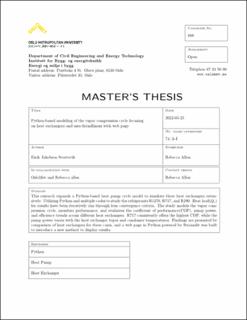| dc.description.abstract | Research into simulating and calculating parameters for heat pumps has been on an upward trajectory,
especially in recent years due to rising electricity prices. A pre-existing Python-based heat pump cycle
has been extended and refined for more comprehensive calculations to heat pumps and, in particular,
heat exchangers. This improved model includes three new heat exchangers: the shell and tube, double
pipe, and plate exchanger, each offering an array of parameters to be calculated. An iterative Python
code has been developed to generate a heat load (Qc) and a user-input required heat load (Qc,rec),
with four convergence criteria, tolerance of: i) Qc and Qc,rec, ii) Qev and Qev1, and iii) condenser
temperatures and iv) evaporator temperatures. The Python code has been validated against CoolTools.
Three cases involving different refrigerants (R2170, R717, and R290) have been computed to collect
information and observe trends between the heat exchangers. The vapor compression cycle is then
modeled in Python, using the converged results for calculated Qc and Qc,rec, and illustrated with T-s
and P-h diagrams. This representation displays the findings by comparing the results of three cases.
The computed results reveal that R717 consistently offers the highest coefficient of performance(COP)
for all three heat exchangers across all cases. The study also measures the pump power required to
circulate water through the condenser and evaporator. Of the three heat exchangers, the double pipe
heat exchanger demands the most power due to its structure and length. Interestingly, as condenser
temperatures rose across the cases, the pump power for water in the condenser decreased. This
occurs in all three cases. In terms of efficiency, R717 emerged as the leader for the shell and tube
exchanger, while R290 outperformed the other refrigerants in the double pipe exchanger. For the plate
exchanger, the three refrigerants demonstrated equal efficiency, although this exchanger displayed the
most significant decline in efficiency as Qc increased.
To present these results in a more appealing and intuitive way, a web page was developed using Python
and Streamlit. This digital tool provides an aesthetic and preferred method to illustrate and review
the research outcomes. | en_US |
